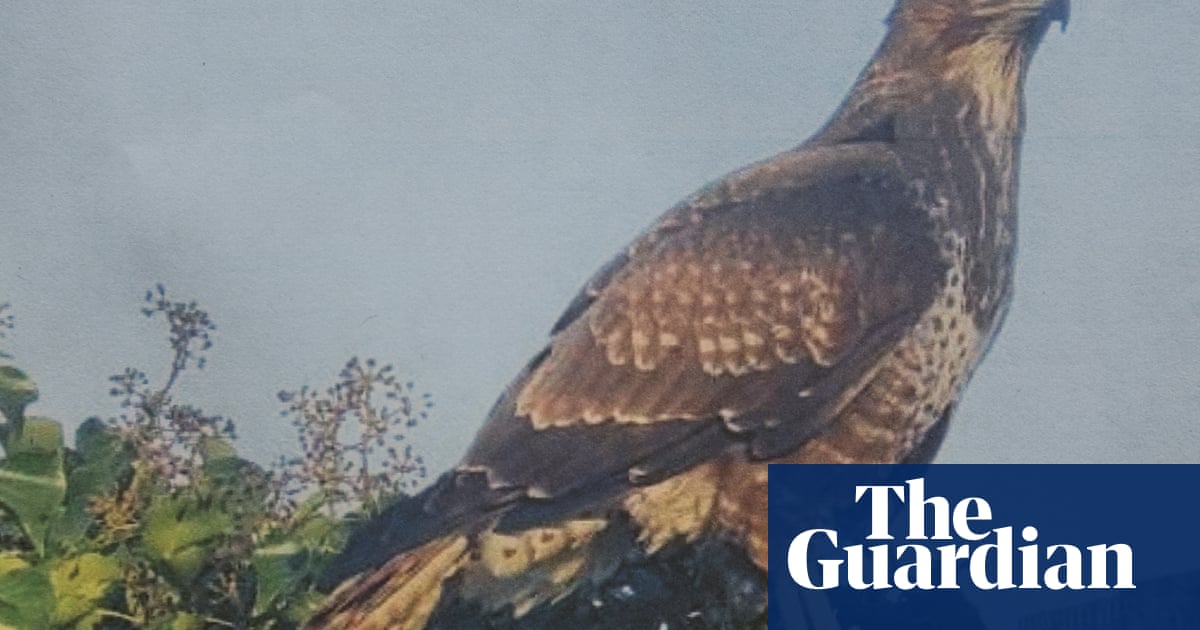A buzzard called Brenda has been terrorising a 300-year-old primary school on the outskirts ofLondon, sending children running for cover while neighbours have been dive-bombed as they put out the bins.
Pupils at Dame Tipping Church of England primary school in the village of Havering-atte-Bower, in the London borough of Havering, have been told they cannot play outside while the bird remains a threat.
Neighbours, meanwhile, who have reported numerous sightings – and a number of attacks – over the past few months, have been advised to carry a large, coloured umbrella as a possible deterrent whenever they go out.
“She’s huge,” said the headteacher, Stella McCarthy, who has had a number of close encounters with Brenda. “She’s really, really big. Her wing span is pretty much my arm span. It’s quite frightening.
“When you see her perched somewhere, it’s lovely. You think, what a beautiful bird. But when you’re outside and you hear that squawk, you don’t have much time. You know she’s coming down.”
It comes just weeks after villagers in Flamstead, near Luton, reported being attacked from behind by aHarris’s hawk. Some were left bleeding and in at least one case requiring hospital treatment.
The pupils in Havering-atte-Bower are being bussed to a neighbouring school for outdoor play, and arrangements are being made to hold sports day elsewhere, but teachers and pupils have embraced Brenda as an opportunity to learn about birds of prey.
She has been spotted perched on school fences, and peering into classrooms. On one occasion, teacher Hannah Graves saw her watching from a nearby rooftop while pupils in years one and two played outside.
“Myself and the teaching assistant quickly got the children back inside, but I didn’t realise the bird was swooping down towards me. My TA shouted to me to get inside quickly. It did shake me up.”
The RSPCA said the buzzard may be protecting her nest or chicks. Pupils, meanwhile, are convinced there is a mate called Barry in the neighbourhood, and there is local speculation that her nest may have been disturbed by nearby renovation work.
In April, theRomford Recordercarried a story about Nikki Dix, 37, who was attacked as she walked in nearby Havering country park. She took a picture of what she thought was a buzzard and carried on walking, then felt a bang on the back of her head. “I was dead shocked,” she said.
On Tuesday, when the Guardian visited the school, equipped with birdwatching binoculars, there were screaming swifts, fat pigeons and cawing crows but neither Brenda, nor any other bird of prey, was to be seen.
But that did not stop parents – and reporters – flinching every time a bird-shaped shadow passed over. Steven Whittle, whose wife, Louise, is among those to have been attacked by the buzzard, cast his eyes nervously up to the skies as he picked up his children from school.
In video footage, his wife can be seen putting out the rubbish in her pink dressing gown and slippers, then walking back to her front door, unaware that a huge bird of prey has swooped down to head level. She ducks at the last moment and is unhurt.
“In the last couple of months, pretty much all the neighbours have had some sort of encounter,” he said. “If you hear a bird making any sort of sound, you are on edge. Every time you leave the house, you’re watching.”
Havering council has been advising the school about possibly hiring a falconry expert who may be able to deter the buzzard. “Buzzards are protected under UK law, therefore our intervention options are very limited, and we have advised that warning signs would be the easiest solution at this time,” a council spokesperson said.
“We completely understand how difficult and worrying this situation is for the school and local residents and we regret that there is not a quick or straightforward solution.”
